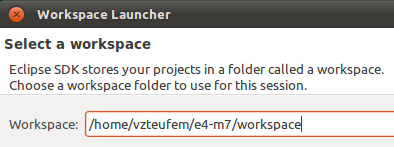e4 SDK 4.1M7 is out and starting with this series I will try to show you how to setup a Development-Environment with wich you can start working in and with e4. I will also explain how to setup important tools like Window Builder, EGit/JGit- and Subversion-Integration. Finally I will end up showing you how to get Kai Tödters Contacs-Demo and my Geo-Application working within Eclipse 4.1 SDK M7.
So let’s start the fun.
First of all you need to download the latest Eclipse 4.1 SDK M7 from here. You could also install e4 0.11M7 on top of an Eclipse 3.7 but I recommend you to do it directly in Eclipse 4.1 just to get started and a basic understanding of the next generation of the Eclipse IDE itself.
Unzip the downloaded file somewhere to your harddisk. I use Ubuntu 11.04 with a JDK 1.6.0_24 installed. On Linux-Sytems I usually install my software into my home directory, so for Eclipse 4.1 SDK M7 i create a directory „e4-m7“ in my home, move the original Zip-File there and unzip it. In the same directory I also create my workspace-folder. Doing it this way you can handle separate installations of Milestone Builds the same time, just a best practice that i figured out while working with all the different Milestone Builds in the past. After Copying and Unzipping, my Eclipse-Installation-Folder looks like this:

Next step is to start Eclipse, in order to do that just go into the folder $HOME/e4-m7/eclipse and doubleclick the eclipse executeable. Eclipse will start up asking you the workspace which you want to use. We use the workspace folder we have create within the e4-m7 folder so we select:

So far nothing special. Some seconds or minutes or hours later Eclipse 4.1 M7 will finally show up. If you get an error message or a small empty box and Eclipse doesn’t come up, it can be that there is a secure_storage file on you computer created by another Eclipse-Installation. This definitely can cause problems. In such a case just delete this file, which is normally located in the folder $HOME/.eclipse/org.eclipse.equinox.security/secure_storage. In a Unix-Terminal just do a rm to delete the file. On Windows please use Explorer to navigate to the file an delete it. After deleting the secure_storage file Eclipse 4.1M7 will start BUT you will loose all informations you entered in previous Eclipse-Installations that have to do with networking, especially the proxy settings. So you have to reenter them, which will of course result in another secure_storage file. On my Ubuntu-Box Eclipse looks quite pretty:

In order to be more productive in our e4 development, the e4 team provides us with further tools which are not part of the Eclipse 4.1 SDK Build. Included in the e4 tools you will find very helpful things like wizards, a graphical Workbench Model Editor and of course the e4 Sourcecode, which in fact is very interesting to learn e4 and to see what is under the hoods. Yeah, we need all this, so let’s go and install that stuff.
Move your mouse pointer to HELP | INSTALL NEW SOFTWARE… and in the upcoming dialog just press the ADD… button to add a new software repository to Eclipse from which we can install additional software. Please enter:
Name: e4 0.11M7
Location: http://download.eclipse.org/e4/downloads/drops/S-0.11M7-201105010200/repository
What are we doing here? We point Eclipse to the Software Repository with all the needed tools. The location/repository is different for every Milestone Build. On the Eclipse Website you’ll find this link on the download site of the e4 0.11M7 Build if you scroll down the page to the bottom. Here you’ll see a link „online repo site“… Some things are hard to find on the Eclipse Website, i know…
After adding this new repository, Eclipse will list you the available software, please select like this:

E4 Resources brings us the sourcecode, e4 Tools includes the wizards and the Workbench Model Editor and e4 XWT provides us with an optional package named „XWT“ which is in the e4 incubator at the moment. With XWT you are able to define your UIs in XML and connect it to the code via XAML-Technology. Really hot stuff and definitely worth to try it out! But back to e4…
After installing please do NOT restart Eclipse. We need further software so why not first installing everything we need and doing the restart at the end?
In professional RCP projects where you create a lot of UI it doesn’t make any sense to create the UI with pure coding. To be really productive we need a graphical tool to create the UI visually like we can do it with Netbeans or Visual Studio. The good news is: With Window Builder Pro (formerly a expensive tool from a company called „Instantiation“, then this company was acquired by Google because of the included Designer for GWT. Google brought Window Builder to the Eclipse Foundation) we have one of the best visual designers around – for free! Let’s install this into our Eclipse 4.1M7.
Again please move you mouse pointer to HELP | INSTALL NEW SOFTWARE… and add the following repository:
Name: Window Builder
Location: http://download.eclipse.org/windowbuilder/WB/integration/3.7
Arrived here please install the following:

At this point you have a fully functional and working development environment for e4. That’s why we are at the end of the first part of this series now. In my next post I will show how to create a first project and play around with Window Builder, after this we move our concentration to EGit/JGit and Subversion…
Have fun!
 Go to the Collaboration section and select all entries starting by „Subversive“:
Go to the Collaboration section and select all entries starting by „Subversive“:  Finish the installation as usual. After restarting Eclipse you’ll automatically get a screen to select a SVN Connector. Depending on your SVN Version please select the version you need. As we have installed SVN 1.6 on our servers I usually select „SVN Kit 1.3.5.“ here. After installing the connector and restarting once again, you can use Subversion. Test it by right clicking into the package explorer and hit IMPORT… besides CVS you now must see SVN also! Congratulations, you are done!
Finish the installation as usual. After restarting Eclipse you’ll automatically get a screen to select a SVN Connector. Depending on your SVN Version please select the version you need. As we have installed SVN 1.6 on our servers I usually select „SVN Kit 1.3.5.“ here. After installing the connector and restarting once again, you can use Subversion. Test it by right clicking into the package explorer and hit IMPORT… besides CVS you now must see SVN also! Congratulations, you are done!








